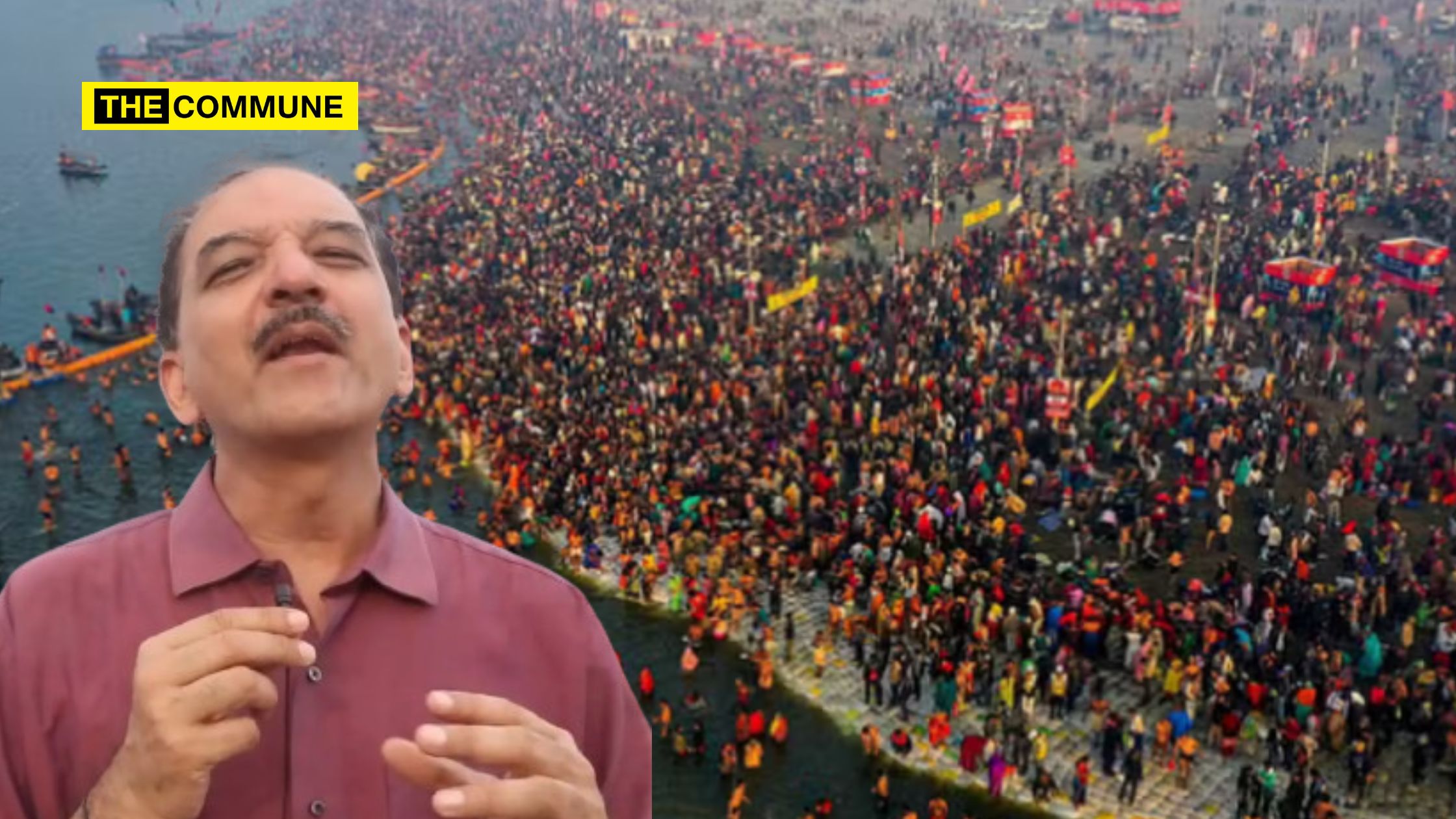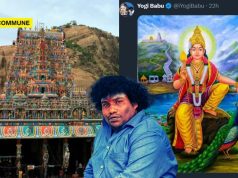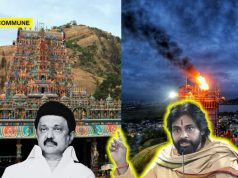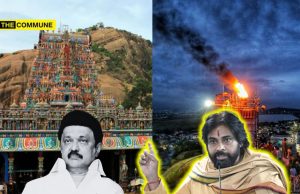
The globally renowned Mahakumbh celebration, which began on 13 January 2025, and will conclude around 26 February 2025, has witnessed an immense turnout of over 50 crore devotees, saints, and pilgrims so far. They have come to bathe in the sacred Triveni Sangam, where the Ganga, Yamuna, and the mythical Saraswati rivers meet. This extraordinary religious event has broken all attendance records.
In this backdrop, political commentator and former sports quiz host Sumanth Raman took to social media to indirectly criticize the event, questioning, “Can anyone explain how the current #Kumbh is a once-in-144-years event? Kumbh occurs every 12 years. So where did the 144 come from? Many visitors keep saying this is a once-in-a-lifetime event. What is the source of this?”
Can anyone explain how the present #Kumbh is a once in 144 year event? Kumbh is held once in 12 years. Where did this 144 come from? Many people who visit keep saying this is a once in a lifetime opportunity. What is the source of this?
— Sumanth Raman (@sumanthraman) February 18, 2025
In his post, Raman not only raised the question but also asked for the source. While a quick Google search could have provided an answer, it seemed his real intention was to get left-wing and Dravidian groups to engage with his post, which largely fell flat. Despite his critique, the origin story and the scientific aspects of Kumbh still hold true today.
What was even more surprising was that former sports quiz host Sumanth Raman relied on a misleading post circulating on WhatsApp University, which falsely claimed that the Mahakumbh happens every 12 years. Even that post was simply a cut, copy, and edit from Wikipedia page. After seeing it, Sumanth started questioning the event without taking the time to verify the information. In reality, the Purna Kumbh takes place once every 12 years, not the Mahakumbh.
The Atharva Veda clearly states: “O saints! The Purna Kumbh occurs every twelve years and is witnessed at the four sacred sites of Haridwar, Prayagraj, Ujjain, and Nashik. Kumbh represents a cosmic event influenced by the alignment of planets and constellations.”
The Kumbh Mela itself is timed based on the astrological positions of Jupiter and the Sun. Jupiter, known as the “Guru of the Gods” in Hindu mythology, takes approximately 12 years (11.86 years, to be precise) to orbit the Sun. Each year, Jupiter transitions into a new zodiac sign, completing a full cycle of the 12 zodiac signs in 12 years. The Kumbh Mela is celebrated when Jupiter enters specific zodiac signs, and the Sun aligns in particular positions, creating an auspicious astrological configuration.
The Maha Kumbh Mela, however, occurs once every 144 years. This is because it signifies the completion of 12 full cycles of the 12-year Kumbh Mela (12 x 12 = 144). For instance, in Prayagraj, the Maha Kumbh Mela takes place when Jupiter is in Taurus and the Sun is in Capricorn, marking an exceptionally rare and sacred alignment. The uniqueness of the Maha Kumbh lies in a rare planetary alignment. It takes place when Jupiter transits over Taurus while the Sun is in Capricorn, along with the presence of the Pushya Nakshatra. This specific alignment happens only once in 144 years, making the 2025 Maha Kumbh Mela particularly significant. While Kumbh Mela occurs every 12 years at Prayagraj, the Maha Kumbh is marked by this extraordinary celestial configuration, which enhances its spiritual and astrological importance.
This once again highlights the danger of spreading half-formed or inaccurate information. Sumanth Raman was caught red-handed for endorsing baseless claims from WhatsApp University without proper fact-checking.
The Story Behind Kumbh Mela
The term “kumbh” comes from the Sanskrit word for pitcher or pot. The legend states that when the Devas and Asuras churned the ocean, Dhanvantari emerged with a pitcher of amrita, the elixir of immortality. To prevent the Asuras from claiming it, Jayant, the son of Indra, ran off with the pot. He was accompanied by the Sun, Shani, Brihaspati (Jupiter), and the Moon, who protected him and the amrita. During his flight, the elixir spilled at four locations: Haridwar, Prayagraj, Ujjain, and Nashik-Trimbakeshwar. Since Jayant ran for 12 days, and one day of the Devas equals one human year, the Kumbh Mela is celebrated every 12 years at these locations, in alignment with the positions of the Sun, Moon, and Jupiter.
Prayagraj and Haridwar also host the Ardh-Kumbh (meaning “half” Kumbh) every six years. The full festival that occurs every 12 years is known as Poorna Kumbh or Maha Kumbh. Each of these four places is situated on the banks of a river—Haridwar on the Ganga, Prayagraj at the confluence (Sangam) of the Ganga, Yamuna, and the mythical Saraswati, Ujjain by the Kshipra, and Nashik-Trimbakeshwar by the Godavari.
It is believed that bathing in these rivers during the Kumbh Mela, especially during the specific celestial alignment, washes away sins and brings spiritual merit (punya). The event also serves as a gathering place for sadhus and other holy figures, with the sadhu akhadas attracting much curiosity. It offers people an opportunity to meet these revered figures and gain spiritual insight.
While the Ganga’s significance in Hinduism is widely known, the Kshipra is said to have emerged from the heart of Vishnu in his Varah (boar) incarnation. The Godavari is often referred to as the “Ganga of the South.”
- Maha Kumbh: The rarest and most sacred Kumbh Mela, celebrated once every 144 years in Prayagraj stands out as a once-in-a-lifetime event, radiating unmatched spiritual energy.
- Purna Kumbh: Held every 12 years in Prayagraj, Haridwar, Nashik, and Ujjain. It is a grand occasion, attracting millions of devotees who come together to perform sacred rituals.
- Ardh Kumbh: A smaller-scale gathering held every 6 years in Prayagraj and Haridwar.
- Magh Mela: An annual event in Prayagraj, taking place during January and February.
An essential part of the festival is the presence of Naga Sadhus, ascetics as a symbol of renunciation.
Why This Maha Kumbh Holds Ultimate Significance
The Maha Kumbh Mela of 2025 is of exceptional importance, as it marks a rare celestial alignment that has not occurred in 144 years. For the first time in over a century, the positions of four major planets will align perfectly, and just three hours before Amavasya on 29 January, the Pushya Nakshatra will align with the four planets. This alignment adds unparalleled astrological significance to this Kumbh Mela, making it the most auspicious one in the past 144 years.
The Kumbh Mela, which occurs four times every 12 years, takes place at one of four sacred locations—Prayagraj, Haridwar, Ujjain, and Nashik—in rotation. The timing of the Kumbh Mela depends on the positions of the Jupiter, Sun, and Moon, as well as the zodiac signs they inhabit. Since Jupiter takes around 12 years to complete its orbit around the Sun, the Kumbh Mela is celebrated four times within that period. The Prayagraj Kumbh Mela, for example, takes place when Jupiter is positioned in Taurus, and the Sun and Moon are aligned in Capricorn.
25th January 2025
As per the configuration of the planetary system and different revolution periods of planets, it is rare to have all planets in a single frame of the sky. In January to February 2025 we can see the planets Jupiter and Mars on eastern sky, Saturn and Venus in… pic.twitter.com/G0AJnOXRjP
— India Meteorological Department (@Indiametdept) January 25, 2025
According to NASA, such planetary alignments involving four or more planets are rare, and the visibility of bright planets like Mars, Jupiter, Saturn, and Venus makes this event even more special. While such alignments do occur periodically, the visibility of multiple bright planets is not an everyday occurrence.
The best time to view the alignment will be about 45 minutes after sunset. Venus, Mars, Jupiter, and Saturn will be visible to the naked eye, while Uranus and Neptune will require a telescope. Venus will shine the brightest, appearing prominently in the southwestern sky, while Mars will glow red in the eastern sky, and Jupiter will dominate the overhead view. Saturn will be visible in the western sky as a small dot. Uranus and Neptune, though part of the alignment, will be too distant for unaided eyes to catch.
This event, while not technically rare in the astronomical sense, holds great importance due to the unique combination of celestial factors and the rare alignment of six planets visible to the naked eye. This adds an extra layer of meaning to the 2025 Maha Kumbh, enhancing its spiritual and astrological significance.
Subscribe to our channels on Telegram, WhatsApp, and Instagram and get the best stories of the day delivered to you personally.




